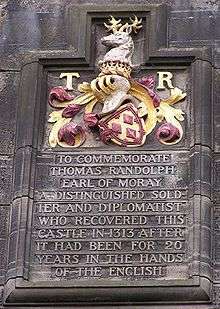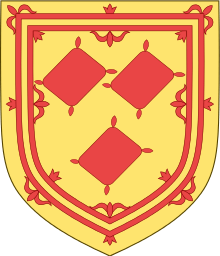Thomas Randolph, 1st Earl of Moray
| The Earl of Moray | |
|---|---|
 Memorial to the Earl of Moray at Edinburgh Castle | |
| Born | c. 1278 |
| Died |
20 July 1332 Musselburgh, East Lothian, Scotland |
| Spouse(s) | Isabel Stewart of Bonkyll |
|
Issue | |
| Father | Sir Thomas Randolph |
| Mother | Isobel Bruce (?) |
Thomas Randolph, Earl of Moray (c. 1278 – 20 July 1332) was an important soldier and diplomat in the Wars of Scottish Independence, who later served as regent of Scotland.
Early life
Thomas was the son of another Thomas, who was Chamberlain of Scotland and Sheriff of Roxburgh, and the grandson of the Randulf or Ranulf who gave the family their surname.[1] It is known that the younger Thomas was the nephew of King Robert the Bruce, but it is uncertain which of Robert's sisters was his mother.[2] The traditional view is that she was of the first marriage of Marjorie, Countess of Carrick, who was mother of Robert by her second marriage. However it is now believed that the King's father Robert married again after Marjorie's death and had with his second wife a daughter, Isabel, who married the elder Thomas.[3][4]
War of Independence

Thomas supported Robert in his attempt to take the throne, and was present at his uncle's coronation in 1306. He was probably knighted by the king then or shortly after. [5] Following the Scottish defeat at the Battle of Methven, he was taken prisoner by the English, coming first under the custody of Sir Adam Gordon and then the Earl of Linoln. During his confinement he joined the English cause, and remained attached to them until he was captured by Sir James Douglas in 1308, and persuaded to rejoin the Scottish side. His defection came to the attention of Edward II of England, who forfeited all his lands, bestowing them on his favourite Hugh le Despencer.[1]
In 1312 Robert created him Earl of Moray, and he became ruler of a large swathe of land in the north of Scotland, far exceeding his southern possessions. He was also made lord of the Isle of Man, in exchange for a reddendo of six ships of 26 oars and 100 silver marks, to be paid at Inverness.[1] Around this time he became one of Robert's most trusted lieutenants, and he seems to have accompanied him on most of his campaigns. His most famous achievement took place on 14 March 1314 when he carried out a daring attack on Edinburgh Castle.[6] This was one of a handful of castles in Scotland still in English hands, and stood on top of an apparently unscalable rock. Amongst Moray's men was William Francis, the son of a former governor of the castle, who knew of a secret path up the rock. Moray used this path to reach the castle, and successfully retook it for the Scots.[7]
Moray played an important role in the Scottish victory at Bannockburn, where he commanded one of the divisions (schiltroms) of the infantry, the others being commanded by King Robert and Edward Bruce, the king's brother.[8][9][10][11]
Ireland
In 1315 Moray accompanied Edward Bruce, the king's brother, during his invasion of Ireland. He was one of the principal leaders in the war against the English settlers in Ireland. He returned twice to Scotland during the war to obtain reinforcements and to get Robert's personal presence in Ireland.[1]
Diplomatic career
Moray's name appears directly after Robert's on the famous Declaration of Arbroath, which was sent to the Pope by the nobles of Scotland to persuade him to recognise Scotland as an independent nation. Later, in 1324, he was sent to meet the Pope in person at his court in Avignon. At this meeting he successfully persuaded the Pope to recognise Robert as King of Scots. The next year the Pope wrote to Moray declaring his hope and trust in his efforts to make peace between England and Scotland, and gave permission for him to visit the Holy Sepulchre in Jerusalem.[1]
Moray was again sent to France in 1325, this time to persuade King Louis X to sign the Treaty of Corbeil renewing the Franco-Scottish alliance, which he did successfully.[12]
After his return to Scotland he had a commanding role in the Battle of Stanhope Park against the English. The English suffered a humiliating defeat, and were forced to sign the Treaty of Edinburgh–Northampton, by which Scotland's independence was finally acknowledged.[1]
Regent
During the King's final years, Moray had been a constant companion, and had superintended the household of the young heir to the throne, David. Before his death, Robert decreed that Moray would serve as regent for David, who was only five years old when he succeeded as king. Moray performed this role justly and wisely, but would unfortunately die at Musselburgh three years later while on his way to repel an invasion by Edward Balliol and his supporters. At the time it was said that he had been poisoned by the English, but it is more likely he died from a kidney stone.[1] His successor as regent was Donald, Earl of Mar.[13]
Marriage and family
Thomas married Isabel, only daughter of Margaret and Sir John Stewart of Bonkyll (killed at the Battle of Falkirk), a brother of James, High Steward of Scotland.[14][15][16] They had two sons and two daughters:[1]
- Thomas, 2nd Earl of Moray
- John, 3rd Earl of Moray
- Agnes Randolph, married Patrick, Earl of Dunbar and had no issue
- Isabel (or Geilis) Randolph, married Sir Patrick Dunbar and had several children, including George, Earl of Dunbar and John, Earl of Moray
References
- 1 2 3 4 5 6 7 8 Paul, Sir James (1909). The Scots Peerage. Edinburgh: David Douglas. Retrieved 2015. Check date values in:
|access-date=(help) - ↑ Bain, Joseph, FSA (Scot)., The Edwards in Scotland, 1296 - 1377, Edinburgh, 1901:61 & 66
- ↑ Weis, Fredk., Lewis, et al., The Magna Charta Sureties 1215, 5th edition, Baltimore, 2002: 50
- ↑ Richardson, Douglas, Plantagenet Ancestry, Baltimore, Md., 2004: 682
- ↑ Penman, Michael Robert the Bruce: King of the Scots p. 98
- ↑ Tabraham, Christopher, 'Edinburgh Castle Official Souvenir Guide'
- ↑ Barbour, John (1375). Barbour, Johne (1375), Skeat, Walter W., ed., The Bruce; or, The Book of the most excellent and noble prince, Robert de Broyss, King of Scots. Early English Text Society, 1870, retrieved 2008-08-17 - in Scots with Modern English annotations.
- ↑ Barbour, The Bruce, p 216.
- ↑ Ross, David R., James the Good, pp. 61-83.
- ↑ Scott, Ronald McNair, Robert the Bruce, pp. 149-152.
- ↑ Traquair, Peter Freedom's Sword
- ↑ Ronald McNair Scott: Robert the Bruce, King of Scots, Hutchinson & Co 1982, p 216
- ↑ Traquair, Peter Freedom's Sword. Collins, 1998. ISBN 978-0-00-472079-1
- ↑ Anderson, William, The Scottish Nation, Edinburgh, 1867, vol.vii: 200.
- ↑ Mackenzie, A.M., M.A., D.Litt., The Rise of the Stewarts, London, 1935: 14n.
- ↑ Simpson, David, The Genealogical and Chronological History of the Stuarts, Edinburgh, 1713: 64-5.